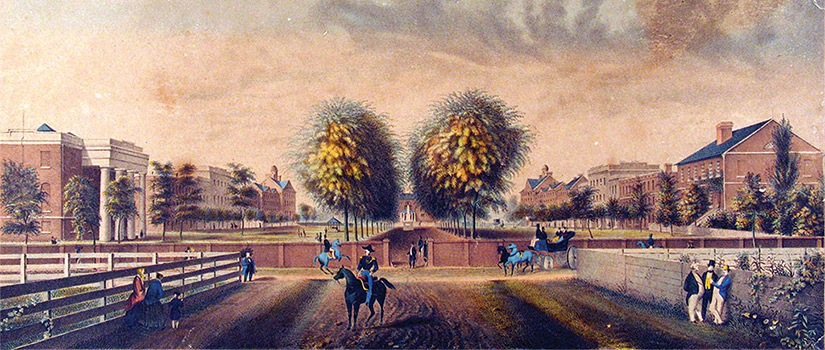Historic Horseshoe
Evolving from a single building, the historic Horseshoe is a living, breathing and
ever-changing blueprint of the university's rich and unique history.
A visit to the University of South Carolina isn't complete without a glimpse of the
historic Horseshoe. The U-shaped original campus — once called South Carolina College — has
seen more than two centuries of history unfold, earning it a position on the National
Register of Historic Places. It's also the place where the university took the necessary
step of acknowledging that the picturesque grounds and the daily life inside its walls
relied upon enslaved workers.
Buildings and Structures
From the time the university was established in 1801, only 12 buildings have helped
create the well-known U-shaped layout of the Horseshoe. Today, many more buildings
reside within the brick Horseshoe Wall that surrounds the grounds of the original
Old Campus. For a detailed history, check out On the Horseshoe: A Guide to the Historic Campus of the University of South Carolina.
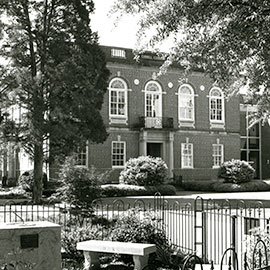
Currell College (1918)
Old Campus building
Architect: Edwards and Sayward
Located behind Rutledge College, Currell College was built as a law school building,
and was originally named Petigru College in honor of distinguished Charleston attorney
James L. Petigru (1789-1863). In fact, names that commemorate noted South Carolina
lawyers and judges remain under the windows as a reminder of the building’s original
purpose.
The name Petigru was transferred to the new law school constructed in 1950, and the
original building was renamed for William Spenser Currell (1858-1943), who served
as university president from 1914 to 1923. Currell guided the university through the
upheaval caused by World War I.
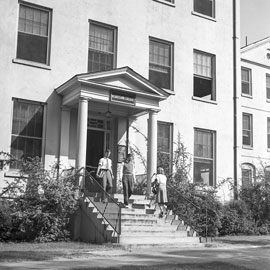
DeSaussure College (1809)
Horseshoe building
Architect: Richard Clark
DeSaussure College was named for Henry William DeSaussure (1763-1839), who served
in the Revolutionary War and later as a politician in both chambers of the South Carolina
legislature. He advocated for the establishment of the college as a member of the
General Assembly in 1801, and he served as one of its first trustees. A lawyer and
later a judge, DeSaussure also served as the second director of the United States
Mint.
The structure, constructed as a twin of Rutledge College, served as a hospital during
the Civil War, and was the site of the first medical school at Carolina from 1866-1873.
During Reconstruction, one wing served as a federal military prison while the university
and the city were occupied. During World War I, one wing served as the first women’s
dormitory.
During the 1970s Horseshoe Restoration Project, archaeologists discovered DeSaussure’s
original foundation had been 100 feet closer to Rutledge.
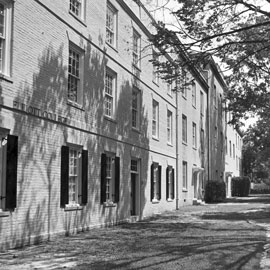
Elliott College (1837)
Horseshoe building
Architect: Unknown
Elliott College was designed solely as student housing and lacks central academic
space. The building was named for Stephen Elliott (1771-1830), a botanist, educator,
state legislator and one of the founders of the State Bank of South Carolina in 1812.
Elliott was also one of the founders of the Medical University of South Carolina in
Charleston in 1825, and he taught natural history and botany at the school until his
death.
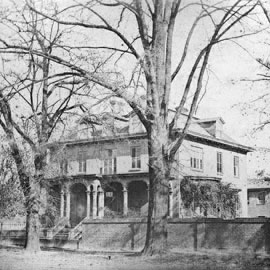
Flinn Hall (1860)
Old Campus building
Architect: Richard W. Johnson (contractor)
Constructed in 1860 as a single faculty residence, Flinn Hall was the last structure
built on the campus prior to the Civil War. The building is named for Philosophy Professor
John William Flinn (1847-1907), who lived in the house circa 1890 until he left the
university in 1905.
In 1910, the building was converted into a YMCA and student activities center and
named Flinn Hall. The building was later converted for academic use. Flinn Hall was
moved back approximately fifty yards to its present location to make room for the
War Memorial.
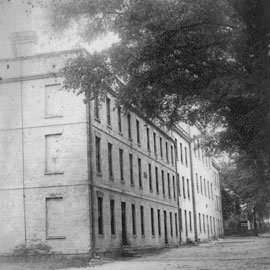
Harper College (1848)
Horseshoe building
Architect: Unknown
Harper College and its twin, Legare, were constructed at the same time and follow
the pattern established by Rutledge College of a central academic section flanked
by wings of student housing. Its third floor meeting hall was used by the Euphradian
Literary Society, one of the first two student organizations at South Carolina College.
The building was named for William Harper (1790-1847), an early graduate of South
Carolina College (1808) who served as a state legislator, United States Senator, judge,
state chancellor and member of the board of trustees.

Horseshoe Wall (1835-1836)
Old Campus structure
Architect: Thomas H. Wade (carpenter); Thomas R. Davis (bricklayer)
The Horseshoe Wall, constructed out of solid brick, originally stood 6 feet 9 inches
high. It wrapped around the campus on Sumter, Greene, Bull and Pendleton Streets,
and the only entrance was on Sumter Street.
The wall failed in its original purpose to prevent students from sneaking into Columbia’s
taverns at night, but helped save the campus during the burning of Columbia during
the Civil War on the night of February 17-18, 1865, by keeping flames off the college
grounds.
The wall has been greatly altered since the 1880s, with portions opened and closed,
lowered and raised. By 1899 the original center entrance on Sumter Street had been
closed and replaced by two openings, giving the old campus its horseshoe shape.

Legare College (1848)
Horseshoe building
Architect: Unknown
Legare College is named for Hugh Swinton Legare (1797-1843), an 1814 alumnus and former
president of the Clariosophic Literary Society. A lawyer, Legare also served as a
state representative, state attorney general, United States congressman, United States
attorney general, charge d’affaires to Brussels and interim United States secretary
of state.
The building's design included a meeting hall on the third floor for the Clariosophic
Literary Society, one of the first two student organizations in Carolina history.
Legare was used as a Confederate hospital during the Civil War and, when the university
was desegregated from 1873-1877 during Reconstruction, it became the primary residence
hall for the predominantly African American student body. Among its residents was
T. McCants Stewart, the first African American graduate of Carolina.
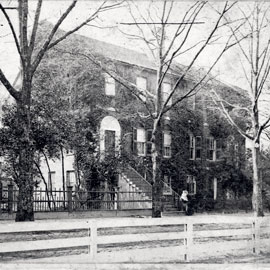
Lieber College (1837)
Horseshoe building
Architect: Thomas H. Wade (contractor)
The third faculty double residence constructed, Lieber College was used as a faculty
residence until the 1940s, when the university ceased providing faculty housing. The
building is named for Francis Lieber (1800-1872), who lived in the house until 1855.
Lieber was an internationally known professor of history and political economy, founder
of the Encyclopedia Americana and one of the college’s most illustrious scholars.
Emma LeConte, daughter of Professor Joseph LeConte, witnessed the burning of Columbia
in February 1865 from the family’s home in Lieber. During the four years in the 1870's
that the university was desegregated, Lieber College was the home of Carolina’s first
African American faculty member, Richard T. Greener (1844-1922).
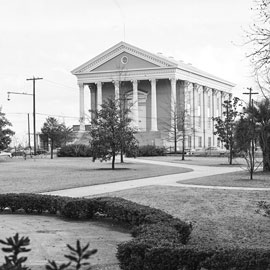
Longstreet Theater (1855)
Old Campus building (the only Old Campus building outside of the Horseshoe Wall)
Architect: Jacob Graves
Originally called College Hall, the building was constructed to be a new college chapel,
but the acoustics were so terrible that it was never used as a chapel.
It was used as a hospital and morgue during the Civil War, as an arsenal and armory
from 1870 to 1887, a science hall in the 1880s and was partially converted into a
gymnasium in 1892. In 1968 the building was named Longstreet Gymnasium for college
president Augustus Longstreet (1790-1870), a secessionist whose oratory during his
tenure from 1857 until 1861 was a factor in the student body’s decision to leave the
college and join the Confederate Army.
During the Horseshoe Restoration Project in the 1970s, the building underwent major
renovations that resolved the acoustic problems and converted it into a theater in
the round.
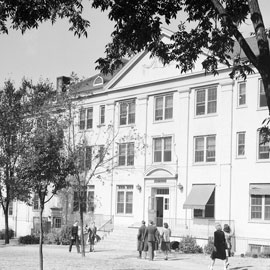
Maxcy College (1937)
Old Campus building
Architect: Lafaye and Lafaye
Maxcy College was constructed as part of an extensive New Deal building program on
the campus during the Great Depression. Originally planned as a student union, the
residence had a popular student lounge in its basement for many years.
It was named for the Reverend Jonathan Maxcy (1768-1820), the first and longest serving
president of the university.
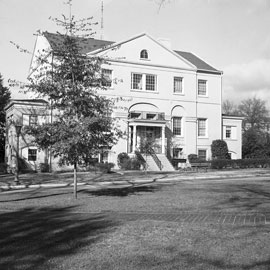
McCutchen House (1813)
Horseshoe building
Architect: Unknown
McCutchen House was the second faculty double residence constructed at South Carolina
College, likely designed after the Blacklock House in Charleston, S.C. The house hosted
two of the longest-serving faculty members in school history — Maximilian LaBorde
(1804-1873) and George McCutchen (1876-1951).
LaBorde occupied half of the duplex during his entire academic career at the college
from 1842 to 1873. An alumnus of South Carolina College, he served as a trustee, state
legislator and secretary of state of South Carolina before joining the college faculty.
The building is named for George McCutchen, who taught economics from 1900 to 1948.
McCutchen lived in the house from 1915 until the university stopped providing faculty
housing in 1945.
In the 1940's, the building was converted to academic use, and then later converted
into a faculty club. In 2003, the College of Hospitality, Retail and Sport Management
took over operation of the McCutchen House as a restaurant management and food service
teaching facility open to the public.
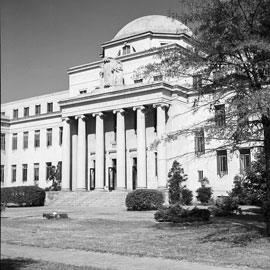
McKissick Museum (1940)
Old Campus building, became current Horseshoe building after 1940 demolition of the
Original President's House
Architect: Henry C. Hibbs
Constructed just behind the original President’s House, McKissick is the only twentieth-century
building on the Horseshoe, replacing the South Caroliniana Library building as the
new main library in 1940. The building was rededicated as a museum in 1984.
The building is named for James Rion McKissick (1894-1944), one of Carolina’s most
beloved presidents, who lay in repose in the building after his sudden death in 1944.
The building was named for him shortly thereafter. The student body petitioned the
board of trustees to allow McKissick to be buried on campus. His grave is in front
of the west wing of the South Caroliniana Library.
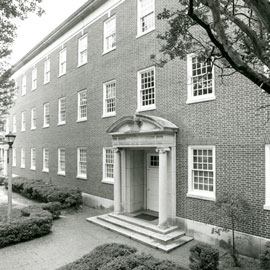
Old Coker College (1962)
Old Campus building
Architect: Lafaye, Fair and Lafaye and Associates
Old Coker College was originally built as the home for the College of Pharmacy and
the Department of Biology. It is the final building constructed inside the Horseshoe
Wall.
It was named for David R. Coker (1870-1938), one of the University’s most outstanding
alumni and a former member of the board of trustees. Coker established Coker’s Pedigreed
Seed Company in Hartsville, S.C., and originated varieties of staple cotton that are
widely cultivated in the United States and other countries. He was considered to be
the South’s foremost agricultural statesman.
The Coker name was transferred to the new biological sciences building in 1976, and
Old Coker College became the home of Arnold School of Public Health until its renovation
as the new College of Information and Communications in 2015.
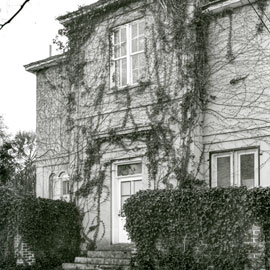
Old Observatory (1852)
Old Campus building
Architect: Jacob Graves
The observatory was built to house a 7-inch telescope acquired by mathematics professor
Mathew J. Williams. The telescope was used in class sessions up to the Civil War.
In 1867 the telescope was stolen, and the building was vandalized.
The Old Observatory was used for a variety of purposes until it was recently renovated
to house administrative offices.
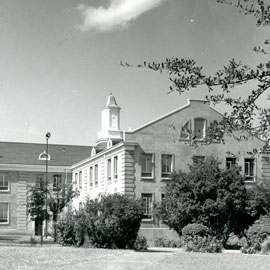
Osborne Administration Building (1952)
Current campus building on Old Campus grounds
Architect: J. Carroll Johnson
Osborne is the first building constructed on campus exclusively to house administrative
offices. In 1973 the building was named in honor of longtime board of trustees member
Rutledge L. Osborne (1895-1984). Osborne was a member of the board from 1947 until
he resigned in 1975 at the age of 80. He served as board chairman from 1952 to 1970,
longer than any individual in the university’s history.
In 1963 the building was the site of the historic second — and final — desegregation
of the University of South Carolina. On September 11, 1963, Henrie Monteith, Robert Anderson and James Solomon received advisement in Osborne
and then walked to the naval armory to register, becoming the first African-American
students at the university since Reconstruction. In 2014, the garden to the north
of the building was renovated and rededicated as the 1963 Desegregation Commemoration
Garden.
Osborne was also the site of a major student riot in May 1970, when a large group
of students briefly took over and ransacked part of the building, trapping President
Thomas F. Jones and members of the board of trustees in their offices. When students
congregated again on the Horseshoe, the South Carolina Army National Guard and the
State Law Enforcement Division used tear gas to disperse them.
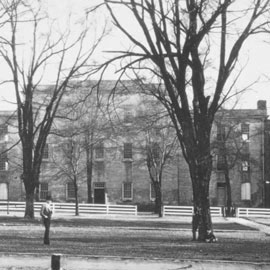
Pinckney College (1837)
Horseshoe building
Architect: Unknown
Pinckney College, like Elliott College, was designed solely as student housing and
lacks the central academic portions of other Horseshoe buildings.
Pinckney is named for Charles Cotesworth Pinckney (1746-1825) and his cousin, Charles
Pinckney (1757-1824). Charles C. Pinckney was a Revolutionary War general, legislator,
diplomat and one of the first members of the college’s board of trustees. Charles
Pinckney was a representative in the Continental Congress, a United States senator
and representative, a state legislator and governor, and United States minister to
Spain. Both men served as delegates to the Constitutional Convention of 1787 and signed
the United States Constitution.
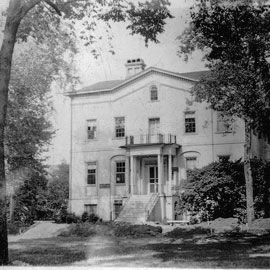
Original President's House (1807)
Horseshoe building, demolished in 1940
Architect: Yates and Phillips [or Philips]
The Original President's House was occupied by every president from 1807-1922, and
hosted a visit from U.S. President William Howard Taft in 1909.
After 1922, its condition was determined to be too poor to continue to serve as the
president’s residence and it was converted to offices. It was demolished in 1940 — the
only major Horseshoe building demolished in the 20th century — after the new library,
now McKissick Museum, was constructed behind it.
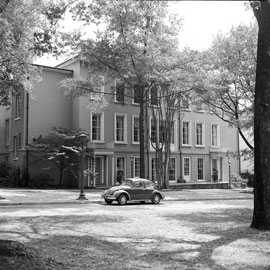
President's House (1810; 1854)
Horseshoe building (as first professor's house)
1810 Architects: Yates and Phillips [or Philips]
1854 Architect: P. H. Hammarskold
Serving as the President's House since the 1950's, the original building on the site
was a faculty double residence erected in 1810. The original structure was demolished
and rebuilt in 1855, and it remained as a faculty residence until the university ceased
providing faculty housing.
President Donald S. Russell renovated the building, converting it into the President's
House. A centerpiece of the campus, it has hosted numerous visiting dignitaries, including
Pope John Paul II in 1987.
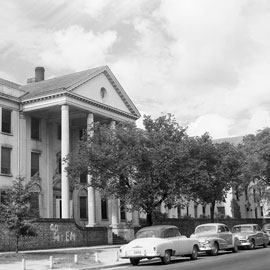
Preston College (1939)
Current campus building on Old Campus grounds
Architect: Hopkins and Baker
Preston College was part of an extensive building program on campus funded by the
New Deal during the Great Depression.
The residence hall was named for William Campbell Preston (1794-1860), who served
as South Carolina College president from 1845 to 1851. A great-nephew of Patrick Henry,
Preston graduated from South Carolina College in 1812. He served as a U.S. Congressman
and U.S. Senator.
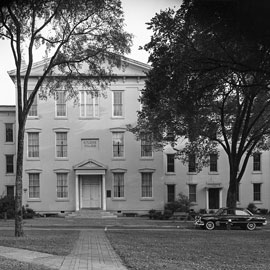
Rutledge College (1805)
Horseshoe building
Architect: Richard Clark; Robert Mills
The original campus building, Rutledge was named in 1848 for brothers John and Edward
Rutledge. John Rutledge (1739-1800), served as governor of South Carolina, a Supreme
Court justice, a state legislator and a United States congressman. His brother Edward
Rutledge (1749-1800) also served as governor of South Carolina and as a state legislator,
and was the youngest signer of the Declaration of Independence.
During the Civil War, Rutledge served as a Confederate hospital. The college was desegregated
from 1873-1877, and Rutledge College hosted the State Normal School, which trained
African-American teachers.
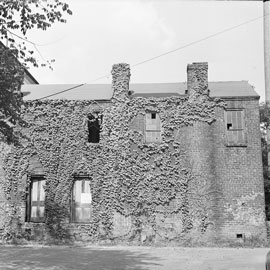
Slave Quarters (1840s)
Old Campus building
Architect: Thomas Wade (contractor)
The last remaining kitchen and slave quarters on campus, other outbuildings were demolished
as campus expanded in the twentieth century. This one survived due to constant use,
primarily as storage.
While students were not allowed to bring slaves to college, faculty members were permitted
to bring house slaves to campus residences. The college relied on a hiring out system
with local owners to supply enslaved workers for the daily operations of the college.
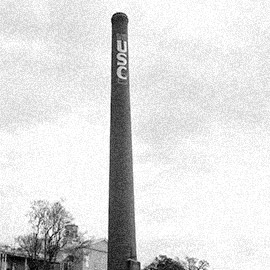
Smokestack (1913)
Old Campus landmark (behind Rutledge College)
The towering smokestack is all that remains of a former campus coal heating plant
that was built around 1913.
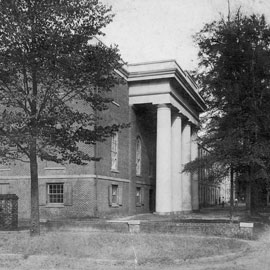
South Caroliniana Library (1840; 1927)
Horseshoe building
Architect: Robert Mills, in part; J. Carroll Johnson
The South Caroliniana Library is the oldest freestanding academic library in the United
States. The structure is based on plans submitted by Robert Mills, a South Carolinian,
the nation’s first federal architect and the designer of the Washington Monument.
The second floor reading room is a replica of the original reading room of the Library
of Congress. Wings designed by J. Carroll Johnson were added in 1927 to provide more
storage and work space.
It served as the main college library for 100 years. The historic building became
the South Caroliniana Library, a repository for published and unpublished materials
relating to the history, literature and culture of South Carolina, and one of the
nation’s top repositories of Southern manuscripts. The term “Caroliniana” means “things
pertaining to Carolina.”
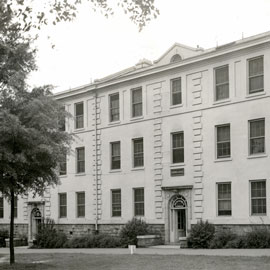
Thornwell College (1913; 1937)
Current campus building on Old Campus grounds
Architect: Charles C. Wilson
Thornwell College was the first residence hall built since Harper College and Legare
College were constructed in 1848. In 1937 the Public Works Administration funded the
addition of two wings.
It is named for alumnus James Henley Thornwell (1812-1862), an 1831 graduate of South
Carolina College who served as president from 1851 to 1855. During his administration,
Thornwell implemented several key changes in the curriculum, including raising entrance
requirements and replacing oral examinations with written ones. He also helped to
calm students during the Guard House Riot of 1856, which nearly resulted in armed
conflict between the students and the local militia and police.
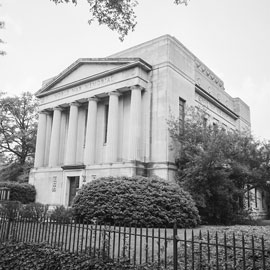
War Memorial (1935)
Current campus building on Old Campus grounds
Architect: Lafaye and Lafaye
The World War Memorial Building is dedicated to the soldiers of South Carolina who
served and died in World War I. It was paid for by private subscription and a federal
grant from the Public Works Administration.
Lafaye and Lafaye designed the building, which has more unique architectural influences
than any other building on campus. The building is currently being used by university
administrative offices and is no longer open to the public.
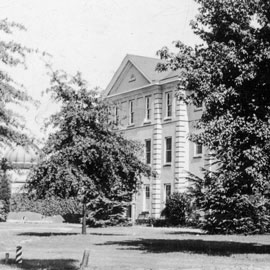
Woodrow College (1914)
Current campus building on Old Campus grounds
Architect: Charles C. Wilson
Named for James Woodrow (1828-1907), Woodrow College was the first dormitory on campus
to have central heating. The building's namesake served as university president from
1891 to 1897. Woodrow instituted changes to the university’s culture, which included
broadening the curriculum and admitting the first women in 1894.
It was used as a hospital during the Influenza Pandemic of 1918.
Trip on Little-Known Brick History
If you look down at the walkway between DeSaussure and McKissick, you might notice
the initials M E E in the brick. The letters recognize Marion E. Evans, an African American brick mason. In 1931, when the university sought to pave the
Horseshoe's dirt pathways , it was an impossible request due to the Great Depression
so students volunteered for the task. Evans helped train the volunteer crew in the
art of brick laying .
Monuments and Green Spaces on the Horseshoe
Lush, aged treescapes and quiet verdant spaces create constellations of calm across
the bustling, 21st century master planned South Carolina campus. The university’s
arboreal stewardship has earned a Tree Campus USA designation from the Arbor Day Foundation,
and the Horseshoe specimens have been named “Heritage Trees of South Carolina.” Explore details
about the university's many monuments and green spaces, including these located on the original campus.
- Desegregation Monument (2024)
- Desegregation Commemorative Garden (2014)
- J. Rion McKissick Grave (1944)
- Kitchen House and Slave Quarters Marker (2017)
- Maxcy Monument (1827)
- Memorial Rose Garden (1960)
- Slavery Historical Marker (2017)
- South Caroliniana Garden (1960)
- Sundial Garden (1970s)
- War Memorial Garden (2018)

